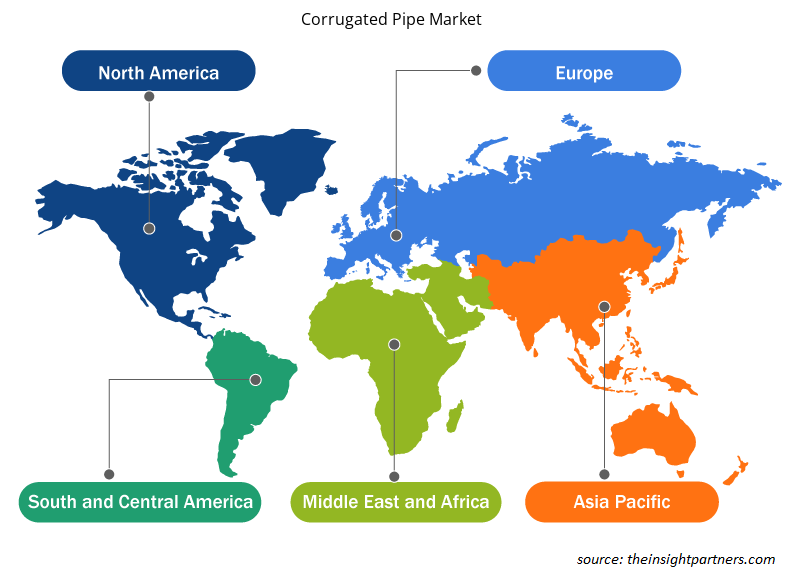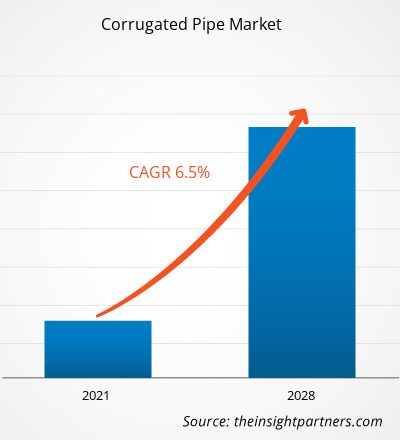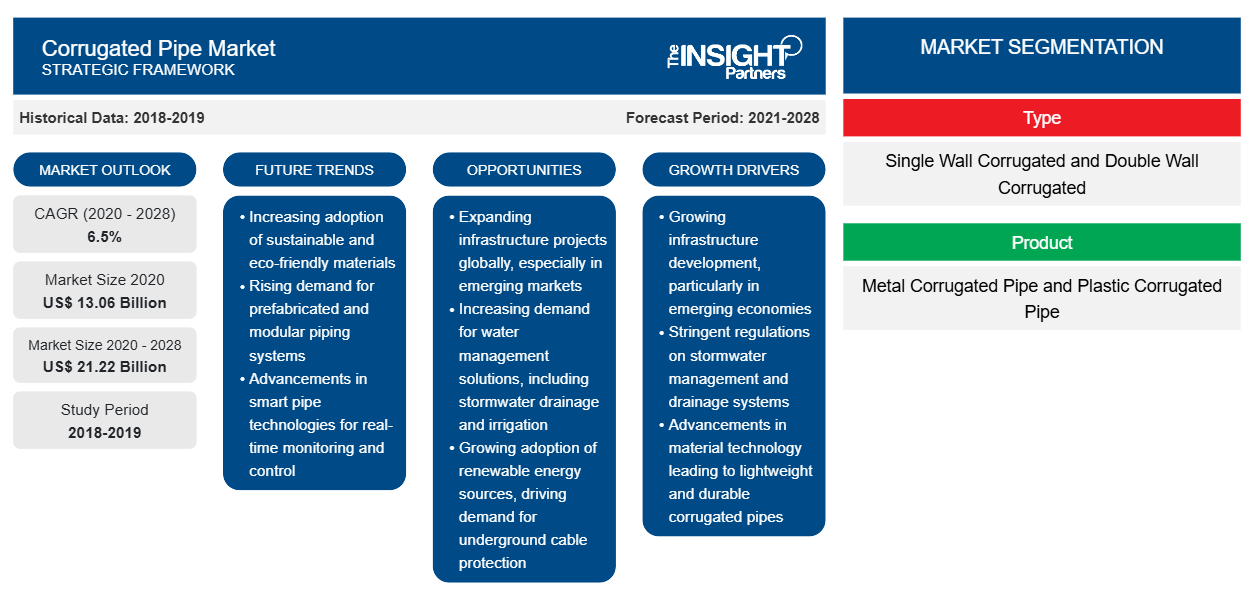El mercado de tubos corrugados se valoró en US$ 13.059,47 millones en 2020 y se proyecta que alcance los US$ 21.221,04 millones en 2028; se espera que crezca a una CAGR del 6,5% entre 2021 y 2028.
Un tubo corrugado tiene una serie de crestas y ranuras que corren paralelas entre sí en su superficie. Los tubos corrugados pueden estar hechos de acero o plásticos como polietileno de alta densidad ( HDPE ) y cloruro de polivinilo (PVC). Los tubos corrugados se utilizan principalmente en aplicaciones como desagües pluviales y alcantarillas donde la flexibilidad, la durabilidad y la resistencia son atributos importantes. La propiedad flexible de los tubos corrugados los hace más útiles y adecuados para una amplia variedad de aplicaciones en comparación con los tubos rígidos y no corrugados.
En 2020, Asia Pacífico representó la mayor parte del mercado mundial de tubos corrugados . Los crecientes avances en los sectores de la fabricación y la construcción están impulsando la demanda de tubos corrugados en esta región. El vasto sector agrícola establecido en países como China e India también está aumentando la demanda de tubos corrugados para su uso en sistemas de riego y drenaje. Junto con este desarrollo, la mayor penetración de las telecomunicaciones en Asia Pacífico está impulsando aún más el crecimiento del mercado de tubos corrugados.
La actual pandemia de COVID-19 ha tenido un impacto significativo en el mercado de tubos corrugados. El brote ha distorsionado la eficiencia operativa e interrumpido las cadenas de valor debido al cierre repentino de las fronteras nacionales e internacionales, lo que ha creado pérdidas de ingresos y daños. Las interrupciones en la producción y la cadena de suministro han tenido un impacto negativo en el mercado de tubos corrugados. Varios países de todo el mundo han tenido situaciones similares a las de confinamiento debido al brote de COVID-19, lo que ha llevado a varias empresas, como la construcción y la agricultura, a funcionar con una capacidad limitada, lo que, a su vez, ha afectado gravemente al mercado de tubos corrugados. Junto con esto, la construcción también se ha desplomado, lo que ha afectado a la demanda de cloruro de polivinilo (PVC) que se utiliza en tuberías. Por tanto, la baja demanda de las industrias de uso final ha tenido un impacto negativo en el mercado de tubos corrugados. Se han realizado diversas investigaciones en países como el Reino Unido, los Países Bajos y España sobre muestras de aguas residuales en busca de signos de COVID-19. El control y la gestión de las aguas residuales han cobrado mayor importancia durante la pandemia, así como el tratamiento de los residuos, incluidos los médicos, domésticos y otros desechos peligrosos, para minimizar los posibles impactos secundarios en la salud y el medio ambiente. Con el aumento de los casos en muchas partes del mundo en desarrollo, se ha prestado mayor atención a la gestión de los residuos. Los gobiernos de varios países se están centrando en la segregación de las aguas residuales, lo que hace que las aguas negras, grises y cargadas de sustancias químicas tóxicas se viertan en arroyos municipales separados. Este enfoque en la gestión de las aguas residuales tendrá un impacto positivo en el mercado de las tuberías corrugadas.
Personalice este informe según sus necesidades
Obtendrá personalización en cualquier informe, sin cargo, incluidas partes de este informe o análisis a nivel de país, paquete de datos de Excel, así como también grandes ofertas y descuentos para empresas emergentes y universidades.
- Obtenga las principales tendencias clave del mercado de este informe.Esta muestra GRATUITA incluirá análisis de datos, desde tendencias del mercado hasta estimaciones y pronósticos.
Perspectivas del mercado
Uso creciente en sistemas de drenaje
Los tubos corrugados tienen una serie de crestas y ranuras en su superficie que corren paralelas entre sí. Estas crestas y ranuras siguen un patrón: son perpendiculares a la línea central de la tubería y la dividen en dos. Los tubos corrugados se utilizan cada vez más en sistemas de alcantarillado y drenaje debido a varias ventajas operativas asociadas con ellos. Los tubos exhiben un rendimiento duradero debido a la baja abrasión de las paredes internas y la resistencia a los ácidos y otros fluidos, y también admiten altas tasas de fluidos. Además, estos tubos son livianos y fuertes. Como resultado, se requiere una baja cantidad de recursos para su instalación y se pueden instalar en áreas restringidas. Estos sistemas de tuberías brindan integridad de unión, exhibiendo así juntas herméticas y a prueba de fugas. Los tubos corrugados también se caracterizan por bajos costos operativos debido al menor costo de transporte, ya que se puede cargar una mayor cantidad de tubos de doble pared en un camión con menos daños durante el almacenamiento y la manipulación, a diferencia de los tubos de concreto. Además, el requisito de una menor cantidad de trabajadores en la instalación reduce los costos de instalación. Los tubos corrugados se pueden utilizar para el drenaje de aguas pluviales, así como para el drenaje subterráneo. Los sistemas de aguas pluviales requieren una amplia gama de tamaños de tuberías y se instalan principalmente en estacionamientos y áreas ajardinadas. Los tubos corrugados de doble pared se utilizan en estas instalaciones de drenaje debido a su durabilidad, robustez y alto rendimiento; la alta durabilidad y robustez los hacen menos propensos a agrietarse. Los sistemas de drenaje subterráneo utilizan comúnmente tubos corrugados de polietileno de alta densidad (HDPE) para dirigir el transporte de agua subterránea. Estos tubos son ideales para controlar los niveles de agua subterránea y la percolación de agua superficial en campos deportivos, campos agrícolas, campos de golf, proyectos de desarrollo de laderas, etc. Por lo tanto, el mayor uso de tubos corrugados en sistemas de drenaje y alcantarillado está impulsando el crecimiento del mercado de tubos corrugados.
Tipo de información
Según el tipo, el mercado de tubos corrugados se segmenta en tubos corrugados de metal y tubos corrugados de plástico. El segmento de tubos corrugados de plástico tuvo la mayor participación del mercado mundial de tubos corrugados en 2020. El tubo corrugado de plástico es uno de los productos de drenaje químicamente más inertes disponibles para los consumidores, lo que lo hace altamente resistente a los gases y productos químicos corrosivos. Los tubos corrugados de plástico están hechos principalmente de polietileno de alta densidad (HDPE), cloruro de polivinilo (PVC) y polipropileno (PP), entre otros, y se utilizan para maniobrar en corredores de servicios públicos congestionados, adaptarse a condiciones únicas del sitio o atravesar terrenos difíciles.
Algunos de los actores clave del mercado que operan en el mercado de tubos corrugados son Advanced Drainage Systems, Bina Plastic Industries Sdn. Bhd, Jain Irrigation Systems Ltd., Fränkische Industrial Pipes Gmbh and Co. Kg, Dura Life India, Contech Engineered Solutions LLC, JM Eagle Inc., Pacific Corrugated Company, Pars Ethylene Kish Co. y TDR Inc. Los principales actores del mercado se están centrando en estrategias como fusiones y adquisiciones y lanzamientos de productos para expandir la presencia geográfica y la base de consumidores.
Perspectivas regionales del mercado de tubos corrugados
Los analistas de Insight Partners explicaron en detalle las tendencias y los factores regionales que influyen en el mercado de tubos corrugados durante el período de pronóstico. Esta sección también analiza los segmentos y la geografía del mercado de tubos corrugados en América del Norte, Europa, Asia Pacífico, Oriente Medio y África, y América del Sur y Central.

- Obtenga datos regionales específicos para el mercado de tubos corrugados
Alcance del informe de mercado de tubos corrugados
| Atributo del informe | Detalles |
|---|---|
| Tamaño del mercado en 2020 | US$ 13.06 mil millones |
| Tamaño del mercado en 2028 | US$ 21,22 mil millones |
| Tasa de crecimiento anual compuesta (CAGR) global (2020-2028) | 6,5% |
| Datos históricos | 2018-2019 |
| Período de pronóstico | 2021-2028 |
| Segmentos cubiertos | Por tipo
|
| Regiones y países cubiertos | América del norte
|
| Líderes del mercado y perfiles de empresas clave |
|
Densidad de actores del mercado de tubos corrugados: comprensión de su impacto en la dinámica empresarial
El mercado de tubos corrugados está creciendo rápidamente, impulsado por la creciente demanda de los usuarios finales debido a factores como la evolución de las preferencias de los consumidores, los avances tecnológicos y una mayor conciencia de los beneficios del producto. A medida que aumenta la demanda, las empresas amplían sus ofertas, innovan para satisfacer las necesidades de los consumidores y aprovechan las tendencias emergentes, lo que impulsa aún más el crecimiento del mercado.
La densidad de actores del mercado se refiere a la distribución de las empresas o firmas que operan dentro de un mercado o industria en particular. Indica cuántos competidores (actores del mercado) están presentes en un espacio de mercado determinado en relación con su tamaño o valor total de mercado.
Las principales empresas que operan en el mercado de tubos corrugados son:
- Sistemas de drenaje avanzados
- Industrias Plásticas Bina Sdn. Bhd
- Sistemas de riego Jain Ltd.
- Fränkische Industrial Pipes Gmbh y Co. Kg
- Dura vida India
Descargo de responsabilidad : Las empresas enumeradas anteriormente no están clasificadas en ningún orden particular.

- Obtenga una descripción general de los principales actores clave del mercado de tubos corrugados
Informe Destacado
- Tendencias progresivas en la industria de tubos corrugados para ayudar a los actores a desarrollar estrategias efectivas a largo plazo
- Estrategias de crecimiento empresarial adoptadas por las empresas para asegurar el crecimiento en los mercados desarrollados y en desarrollo
- Análisis cuantitativo del mercado mundial de tubos corrugados de 2019 a 2028
- Estimación de la demanda de tubos corrugados en diversas industrias
- Análisis de Porter para ilustrar la eficacia de los compradores y proveedores que operan en la industria para predecir el crecimiento del mercado
- Desarrollos recientes para comprender el escenario competitivo del mercado y la demanda de tubos corrugados
- Tendencias y perspectivas del mercado junto con los factores que impulsan y restringen el crecimiento del mercado de tubos corrugados
- Comprensión de las estrategias que sustentan el interés comercial en relación con el crecimiento del mercado mundial de tubos corrugados, lo que ayuda en el proceso de toma de decisiones.
- Tamaño del mercado de tubos corrugados en varios nodos del mercado
- Descripción detallada y segmentación del mercado mundial de tubos corrugados, así como de la dinámica de su industria
- Tamaño del mercado de tubos corrugados en varias regiones con oportunidades de crecimiento prometedoras
Mercado de tubos corrugados por tipo
- Corrugado de pared simple
- Corrugado de doble pared
Mercado de tubos corrugados por producto
- Tubo corrugado de metal
- Tubo corrugado de plástico
Mercado de tubos corrugados por aplicación
- Conducto para cables de alimentación y conducto para cables de telecomunicaciones
- Líneas de drenaje y alcantarillado
- Construcción y edificación
Perfiles de empresas
- Sistemas de drenaje avanzados
- Industrias Plásticas Bina Sdn. Bhd
- Sistemas de riego Jain Ltd.
- Fränkische Industrial Pipes Gmbh y Co. Kg
- Dura vida India
- Soluciones de ingeniería Contech LLC
- Compañía: JM Eagle Inc.
- Compañía corrugada del Pacífico
- Compañía de etileno Pars Kish
- TDR Inc
- Análisis histórico (2 años), año base, pronóstico (7 años) con CAGR
- Análisis PEST y FODA
- Tamaño del mercado, valor/volumen: global, regional y nacional
- Industria y panorama competitivo
- Conjunto de datos de Excel
Informes recientes
Testimonios
Razón para comprar
- Toma de decisiones informada
- Comprensión de la dinámica del mercado
- Análisis competitivo
- Información sobre clientes
- Pronósticos del mercado
- Mitigación de riesgos
- Planificación estratégica
- Justificación de la inversión
- Identificación de mercados emergentes
- Mejora de las estrategias de marketing
- Impulso de la eficiencia operativa
- Alineación con las tendencias regulatorias





















 Obtenga una muestra gratuita para - Mercado de tubos corrugados
Obtenga una muestra gratuita para - Mercado de tubos corrugados